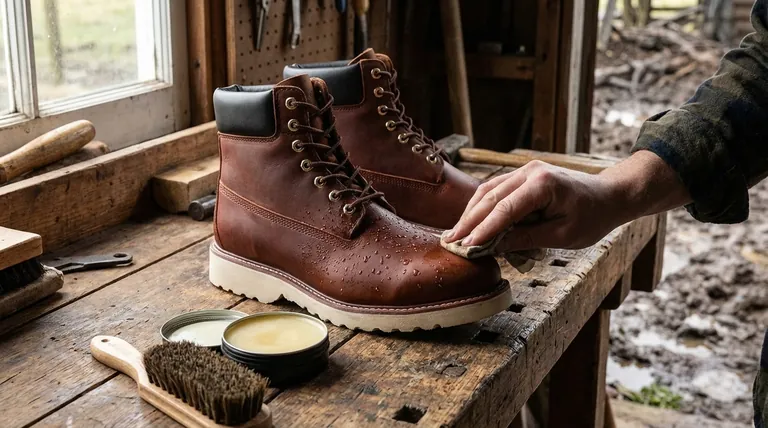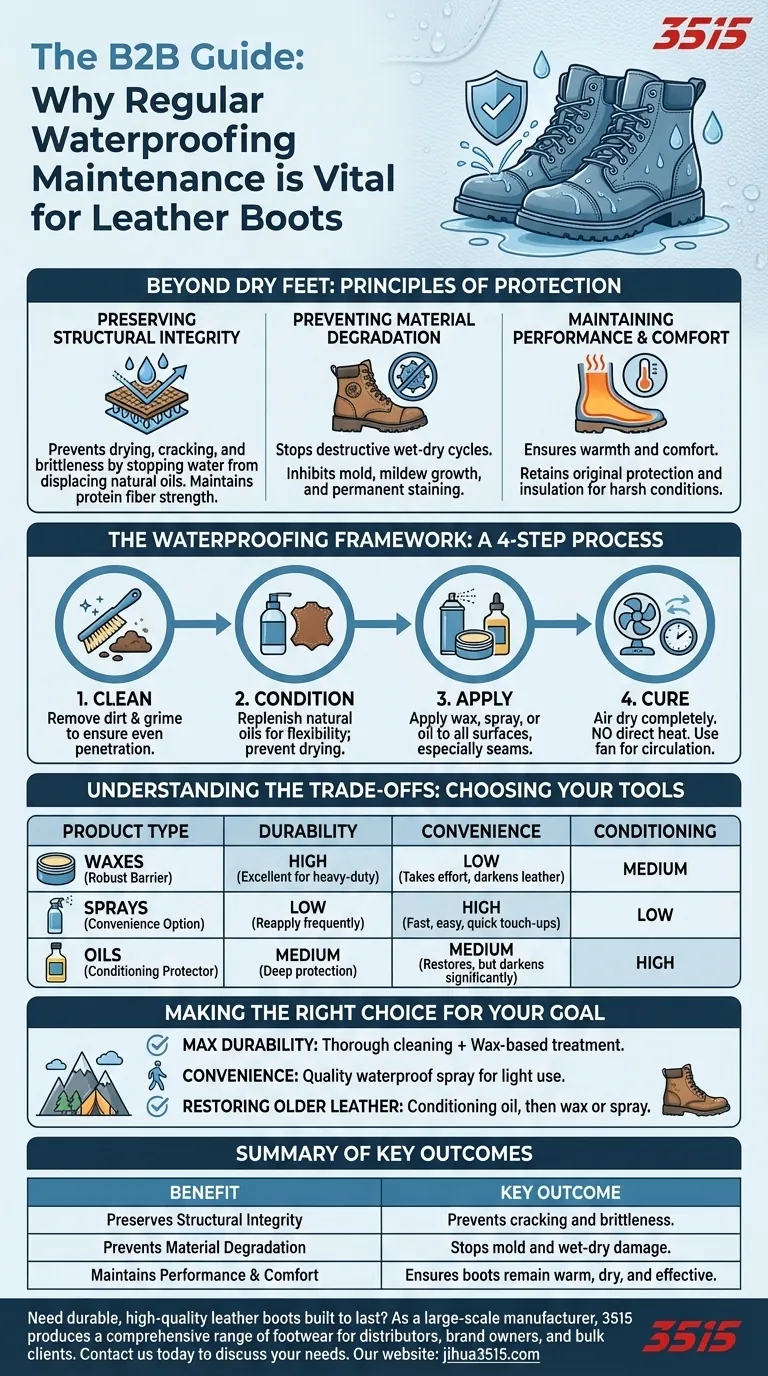At its core, regular waterproofing maintenance is a crucial investment in the longevity of your leather boots. This process extends their functional lifespan by creating a protective barrier against moisture, which prevents the leather from weakening, cracking, and degrading. It ensures your boots remain durable and reliable, especially when exposed to harsh or wet environments.
The primary goal of waterproofing isn't to turn leather into an impermeable plastic, but to preserve its natural strength, flexibility, and breathability while shielding it from the damaging effects of water saturation.

Beyond Dry Feet: The Principles of Protection
Proper maintenance goes far beyond simply keeping water out. It's a system designed to preserve the very material your boots are made from.
Preserving Structural Integrity
When leather becomes saturated, the water bonds with its natural oils. As the water evaporates, it pulls these essential oils out, leaving the leather's protein fibers dry, brittle, and prone to cracking. A waterproof barrier prevents this initial saturation.
Preventing Material Degradation
Constant exposure to a wet-and-dry cycle accelerates wear and tear. Moisture can also encourage the growth of mold and mildew, which can permanently damage and stain the leather. Regular treatment stops this destructive cycle before it starts.
Maintaining Performance and Comfort
Dry feet are warmer and more comfortable. Waterproofing ensures your boots continue to provide the protection and insulation they were designed for, making them more effective in cold or wet conditions.
The Waterproofing Framework: A Step-by-Step Process
Effective waterproofing is a methodical process, not a single action. Each step builds upon the last to create a durable and effective shield.
Step 1: The Foundation of a Thorough Cleaning
You cannot protect dirty leather. Use a brush to remove all loose mud and grime. This ensures that the conditioning and waterproofing agents can penetrate the leather's pores evenly instead of just sitting on top of a layer of dirt.
Step 2: Conditioning the Leather
Before sealing the surface, you must replenish the leather's natural oils. Apply a conditioning oil or cream to keep the material supple and prevent it from drying out under the waterproofing layer. This step is vital for long-term flexibility.
Step 3: Applying the Waterproofing Agent
Apply your chosen product—wax, spray, or oil—to all exterior surfaces. Pay close attention to high-stress areas like seams, creases, the tongue, and around the eyelets. Use a seam sealer on the stitching for an extra layer of reinforcement.
Step 4: The Critical Curing Process
Allow the boots to dry completely in a warm, well-ventilated area. Crucially, do not use direct heat from a radiator or fire, as this will damage the leather and compromise the treatment. A fan can be used to improve air circulation and speed up the process.
Understanding the Trade-offs: Choosing Your Tools
Different waterproofing products offer distinct advantages and require different levels of commitment. There is no single "best" option; the right choice depends on your boots and your needs.
Waxes: The Durable Barrier
Boot wax is melted into the leather's surface, creating a robust and long-lasting waterproof finish. It is excellent for heavy-duty work or hiking boots but requires more effort to apply and can slightly darken the leather.
Sprays: The Convenience Option
Waterproofing sprays are fast and easy to apply, making them ideal for quick touch-ups or for boots made of mixed materials. However, their protection is less durable and typically needs to be reapplied every month or after significant exposure to water.
Oils: The Conditioning Protector
Certain oils both condition and protect the leather. They are excellent for restoring older boots and providing a deep level of protection. The main trade-off is that they will almost always darken the color of the leather significantly.
Making the Right Choice for Your Goal
Select your maintenance strategy based on how you use your boots and the level of protection you require.
- If your primary focus is maximum durability in harsh conditions: A thorough cleaning followed by a wax-based treatment provides the most robust and long-lasting barrier.
- If your primary focus is convenience for casual or light use: A quality waterproof spray offers quick and easy protection that is sufficient for less demanding environments.
- If your primary focus is restoring and protecting older, dry leather: Begin with a conditioning oil to replenish the material, then apply a wax or spray to lock in the moisture and add a protective layer.
Ultimately, consistent maintenance transforms a simple pair of boots into reliable, long-lasting gear you can depend on.
Summary Table:
| Benefit | Key Outcome |
|---|---|
| Preserves Structural Integrity | Prevents leather from drying out, cracking, and becoming brittle. |
| Prevents Material Degradation | Stops mold, mildew, and the damaging wet-and-dry cycle. |
| Maintains Performance & Comfort | Ensures boots remain warm, dry, and effective in harsh conditions. |
Need durable, high-quality leather boots built to last?
As a large-scale manufacturer, 3515 produces a comprehensive range of footwear for distributors, brand owners, and bulk clients. Our production capabilities encompass all types of durable shoes and boots designed to withstand demanding environments.
Contact us today to discuss your needs and discover how we can provide reliable footwear solutions for your business.
Visual Guide

Related Products
- Wholesale Leather Work Boots with Customizable Wedge Sole for Brands
- Safety Footwear Wholesale Manufacturer for Custom OEM/ODM Production
- Durable Leather Work Boots for Wholesale & Custom OEM Manufacturing
- Premium Flame-Retardant Waterproof Safety Boots and Shoes
- Premium Wholesale Waterproof Safety Boots High Performance Protection for Industrial Markets
People Also Ask
- What is the complete process for deep cleaning leather work boots? A Step-by-Step Guide to Preserve Your Investment
- How does cleaning your work boots help in their maintenance? Extend Lifespan & Boost Safety
- What maintenance tips are recommended for leather safety footwear? Extend Lifespan & Preserve Safety
- What are the advantages of leather uppers in work boots? Unmatched Durability & Protection
- What are the best practices for storing leather work boots? Preserve Your Investment for Years



















